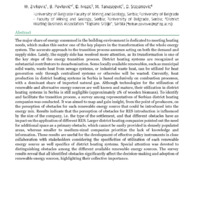Towards more sustainable district heating systems in Serbia - Options and obstacles
Објеката
- Тип
- Саопштење са скупа штампано у изводу
- Верзија рада
- објављена
- Језик
- енглески
- Креатор
- Marija Živković, Boban Pavlović, Dejan Ivezić, Miloš Tanasijević, Dejan Stojanović
- Извор
- Conference on Sustainable Development of Energy, Water and Environmental Systems, Rome, September 8-12, 2024
- Издавач
- Zagreb : Faculty of Mechanical Engineering and Naval Architecture
- Датум издавања
- 2024
- Сажетак
- The major share of energy consumed in the building environment is dedicated to meeting heating needs, which makes this sector one of the key players in the transformation of the whole energy system. The accurate approach to the transition process assumes acting on both the demand and supply sides. Lately, the supply side has received more attention, as its transformation is one of the key steps of the energy transition process. District heating systems are recognized as substantial contributors to decarbonization. Some locally available renewables, such as municipal solid waste, waste heat from sewage systems, or industrial waste heat, can be utilized for heat generation only through centralized systems, or otherwise will be wasted. Currently, heat production in district heating systems in Serbia is based exclusively on combustion processes, with a dominant share of imported natural gas. Although technologies for the utilization of renewable and alternative energy sources are well known and mature, their utilization in district heating systems in Serbia is still negligible (approximately 2% of wooden biomass). In order to identify and facilitate the transition process, a survey among representatives of Serbian district heating companies was conducted. It was aimed to map and gain insight, from the point of producers, on the perception of obstacles for each of renewable energy source that could be introduced into energy mix. Results indicate that the perception of obstacles for RES introduction is influenced by the size of the company, i.e. the type of the settlement, and that different obstacles have an impact on the application of different RES. Larger district heating companies pointed out the need for additional space as a primary obstacle, which cannot be easily provided in densely populated areas, whereas smaller to medium-sized companies prioritize the lack of knowledge and information. These results are useful for development of effective policy instruments in close collaboration with stakeholders considering specificities of utilization of each renewable energy source as well specifics of district heating systems. Special attention was devoted to distinguishing obstacles among the different available renewable energy sources. The survey results reveal that all identified obstacles significantly affect the decision-making and adoption of renewable energy sources, highlighting their collective importance.
- почетак странице
- 405
- крај странице
- 405
- issn
- 2706-3690
- Subject
- energetska tranzicija, daljinsko grejanje, dekarbonizacija, obnovljivi izvori energije, prepreke, Srbija
- Energy transition, district heating, decarbonization, renewable energy sources, obstacles, serbia
- Шира категорија рада
- М30
- Ужа категорија рада
- М34
- Је дио
- Istraživanje sprovedeno uz podršku Fonda za nauku Republike Srbije, 4344, Forward-Looking Framework for Accelerating Households' Green Energy Transition – FF GreEN
- Права
- Отворени приступ
- Лиценца
- Creative Commons – Attribution-NonComercial-Share Alike 4.0 International
- Формат
- Медија
 SDEWES2024_BoA-407.pdf
SDEWES2024_BoA-407.pdf
Marija Živković, Boban Pavlović, Dejan Ivezić, Miloš Tanasijević, Dejan Stojanović . "Towards more sustainable district heating systems in Serbia - Options and obstacles" in Conference on Sustainable Development of Energy, Water and Environmental Systems, Rome, September 8-12, 2024, Zagreb : Faculty of Mechanical Engineering and Naval Architecture (2024) М34
This item was submitted on 19. новембар 2024. by [anonymous user] using the form “Рад у зборнику радова” on the site “Радови”: http://drug.rgf.bg.ac.rs/s/repo
Click here to view the collected data.